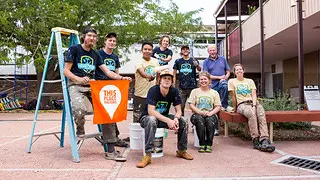
Painting the Desert
How a Neutra Marvel in Arizona Is Inspiring Multiple Generations
Back in 2007, Brad Traver was sent to the Petrified Forest National Park on a temporary assignment. The nearly 150-mile park, located in eastern Arizona, is best known for its large deposits of petrified wood, a beautiful natural phenomenon, which attracts tens of thousands of visitors each year.
But what stuck with him the most after this work detail had nothing to do with the millennia-old fossils for which the park is so famous. Traver, interested in historic preservation his whole life, found that he was blown away by another of the park’s unique offerings: The Painted Desert Community Complex.

photo by: Minesh Bacrania
The Modernist building was designed by Richard Neutra and Robert Alexander.
This Modernist marvel was designed by renowned architects Richard Neutra and Robert Alexander as a part of the National Park Service’s Mission 66 program, which worked to improve park facilities throughout the country after World War II. The Community Complex was, as Traver describes, “one of the most ambitious projects” to come out of the program, and was made even bolder through the Park Service’s choice of architects. However, this one-of-a-kind park facility remains relatively unknown to most Americans -- and as Traver admits, he was no exception.
“I didn’t know it was here. I’d lived in Arizona for 25 years at that point and didn’t know it was here. I was just blown away by how unique this place was,” said Traver. “That was an important milestone for me, because that was what made me want to come back here on a permanent basis.”

photo by: Minesh Bacrania
Traver, now the park’s Superintendent, gets to spend most of his days in and around the Modernist jewel deep in the heart of the American southwest. Now, through his position with the park, and partnership with the National Trust for Historic Preservation, he is hoping to give the building that had inspired him its day in the sun. But, as he will be the first to say, putting the Painted Desert Community Complex on the map is no small task.
“Of the 800,000 visitors that come to this park every year, I’d be surprised if 500 knew about the Complex. Most of the public doesn’t know anything about it. At least until we’re able to turn the tide here,” said Traver. “The Trust has been very helpful in getting that tide to begin to turn by naming it a National Treasure, and bringing in historic preservation partners in Arizona.”
In addition to naming the structure a National Treasure in 2014, the Complex has also been the site of a HOPE Crew project this summer. The project, overseen by preservation expert David Charlebois and undertaken by crew members from the Arizona Conservation Corps, has aimed to restore the original paint colors to the exterior, thanks to a paint analysis by the Historic Resources Group and a generous paint donation from Valspar.

photo by: Minesh Bacrania
The metal accents on the Community Complex were restored to their original red color.
“These young men and women are showing that pride of accomplishment, and that’s a wonderful thing to pass on...one day I’ll set down my paintbrush, my hammer, and my trowel, and it will be up to others. I’m confident now that it will be in good hands.”
David Charlebois, preservation expert

photo by: Minesh Bacrania
Beyond simply teaching crew members the basic skills of preservation on this project, Traver and Charlebois made it a point to inspire these young people by incorporating the history and significance of the building into their learning.
“If they did not have an appreciation, if they were not taught how this building came about, they would walk away from here with nothing more than the idea of how to put paint on a wall,” said Charlebois. “But now, they have a grasp of what the whole concept is: to preserve this building, give it new life for the next generation, so that their children’s children can see the beauty of the architecture, the beauty of the scenery, and how delightfully it blends together. What a gift that is!”
Charlebois, a veteran himself of thousands of preservation projects, also found himself inspired by the work of the crew itself. Not only did they prove themselves to be capable apprentices, they also showed they have what it takes to be stewards for this, and other important pieces of architecture, for years to come.

photo by: Minesh Bacrania
This project was made possible in part by a generous donation from Valspar.
“I’ve never worked with a group that’s been more attentive, tried as hard, and has done so well so quickly. This is an exceptional group,” said Charlebois. “These young men and women are showing that pride of accomplishment, and that’s a wonderful thing to pass on. I only have a few thousand more buildings to do, but one day I’ll set down my paintbrush, my hammer, and my trowel, and it will be up to others. I’m confident now that it will be in good hands.”
Through the HOPE Crew and National Treasures programs, the Painted Desert Community Complex has found itself in the news multiple times, including pieces featured on MSN.com and in the Arizona Journal. It’s just the beginning, but work like this will continue to, as Traver says, turn the tide for a building that has touched these lives, and has the potential to inspire many more in years to come.



